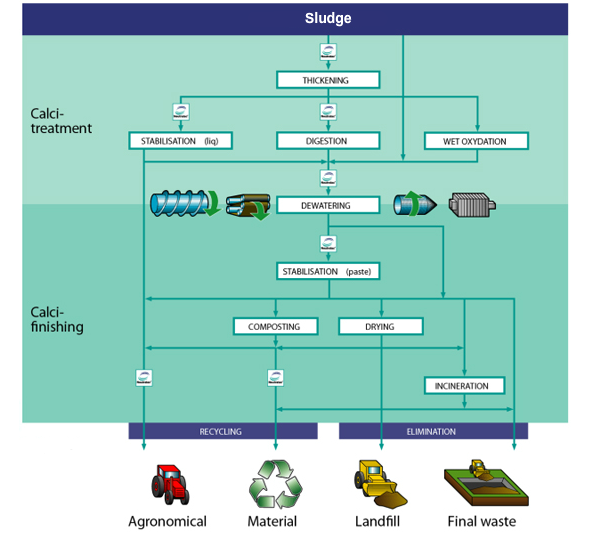 Drying Technology
Drying Technology
Sludge treatment, in order to improve sludge dewatering and produce sludge adapted to the chosen disposal route, while respecting the environment
Where does sludge come from?
From wastewater treatment, in certain cases notably from bio processes, a solid waste or sludge is also produced. Indeed, wastewater treatment reduces the solved and unresolved pollutants existing in the wastewater. These are to be regained in the sewage sludge at the end of the water treatment.In addition to this type of sludge, other sludge exist that require treatment. Amongst these are other organic sludge, from animal origin (manure, slaughterhouse sludge), from food industry, and mineral sludge such as steel industry and dredging sludge, tunnel and drilling sludge, sludge from the construction field, etc.Some types of sludge are a result of natural processes, while other types of sludge are produced in industrial processes such as by filtering of liquids.
Why sludge treatment is necessary?
After the clarification step during wastewater treatment, sludge are very voluminous and still ferment a lot. The goals of sludge treatment are to reduce and ameliorate sewage sludge characteristics for the further utilization or disposal. After their treatment, sludge may be discharged or reused back into the environment.
What do we exactly do for sludge treatment?
Sludge need to be treated, involving multi-process solutions. Sludge are stabilized in order to control the degradation of organic ingredients and to remove odors, their volume is reduced, and they are hygienized (pathogen organisms are eliminated).
Sludge treatment, an elaborate process to recycle or dispose of sludge in a safe, effective and sustainable manner
Sludge treatment, step by step
The sludge accumulated in a wastewater treatment process must be treated and disposed of in a safe and effective manner.
The choice of a sludge treatment method depends on the amount of sludge generated and other site-specific conditions.
The design of sludge management and minimization strategy must target reduction at every step of the sludge generation chain:
- in the production process, to reduce waste and then reduce sludge production,
- in the wastewater treatment plant, by using new adapted technology that reduces the amount of sludge produced per amount of BOD treated,
- in the disposal methods, to select the most stable and most economical route
Sludge treatment is an elaborate process being usually performed in several phases.

Sludge treatment flowchart
Shincci Offers in sludge treatment:
SHS INTEGRATED BELT-TYPE SLUDGE DRYER
SHS WASTE HEAT INTEGRATED BELT-TYPE SLUDGE DRYER
CONTAINER DRYER
This article is from this page, welcome to click it to read the full content.